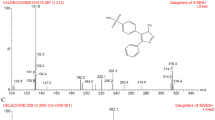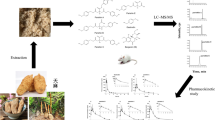Abstract
Background and Objectives
There have been no animal experiments and clinical studies on the pharmacokinetic interaction between rivaroxaban and enalapril. To investigate whether a potential pharmacokinetic interaction is present between rivaroxaban and enalapril, a rapid and sensitive Ultra performance liquid chromatography—tandem mass spectrometry (UPLC–MS/MS) method was developed and validated to determine the concentration of rivaroxaban and enalapril in rat plasma and was then applied to a pharmacokinetic interaction study.
Methods
The analytes were separated on an Acquity UPLC BEH C18 chromatography column (2.1 × 50 mm, 1.7 μm) with acetonitrile and 0.1% formic acid as the mobile phase with gradient elution. The mass spectrometer was operated in multiple reaction monitoring mode to monitor the precursor-to-product ion transitions of 436.1 → 145.1 m/z for rivaroxaban, 377.3 → 234.2 m/z for enalapril and 285.2 → 193.1 m/z for diazepam (IS).
Results
The method was validated over the concentration range of 1.0–200 ng/mL for rivaroxaban and 0.5–100 ng/mL for enalapril. The intra- and inter-day precision and accuracy of the quality control (QC) samples exhibited relative standard deviations (RSD) < 9.4% and the accuracy values ranged from − 8.3 to 9.6%. After co-administration of rivaroxaban and enalapril, the maximum plasma concentration (Cmax) and area under the systemic drug concentration–time curve from time 0 to infinity (AUC0–∞) of rivaroxaban were significantly increased by 19.6% (p < 0.05) and 21.3% (p < 0.05), respectively. On the contrary, the plasma clearance rate (CL/F) of rivaroxaban and enalapril was significantly decreased by 17.8% (p < 0.05) and 23.8% (p < 0.05), respectively.
Conclusions
The UPLC–MS/MS method was successfully applied to simultaneous determination of rivaroxaban and enalapril in rat plasma and applied to study the pharmacokinetic interaction between rivaroxaban and enalapril. The co-administration of rivaroxaban and enalapril resulted in a significant drug interaction in rats.




Similar content being viewed by others
References
Perzborn E, Roehrig S, Straub A, Kubitza D, Misselwitz F. The discovery and development of rivaroxaban, an oral, direct factor Xa inhibitor. Nat Rev Drug Discov. 2011;10(1):61–75.
Eriksson BI, Kakkar AK, Turpie AG, Gent M, Bandel TJ, Homering M, et al. Oral rivaroxaban for the prevention of symptomatic venous thromboembolism after elective hip and knee replacement. J Bone Joint Surg Br Vol. 2009;91(5):636–44.
Eriksson BI, Borris LC, Friedman RJ, Haas S, Huisman MV, Kakkar AK, et al. Rivaroxaban versus enoxaparin for thromboprophylaxis after hip arthroplasty. N Engl J Med. 2008;358(26):2765–75.
Kakkar AK, Brenner B, Dahl OE, Eriksson BI, Mouret P, Muntz J, et al. Extended duration rivaroxaban versus short-term enoxaparin for the prevention of venous thromboembolism after total hip arthroplasty: a double-blind, randomised controlled trial. Lancet. 2008;372(9632):31–9.
Lassen MR, Ageno W, Borris LC, Lieberman JR, Rosencher N, Bandel TJ, et al. Rivaroxaban versus enoxaparin for thromboprophylaxis after total knee arthroplasty. N Engl J Med. 2008;358(26):2776–86.
Antoniou S. Rivaroxaban for the treatment and prevention of thromboembolic disease. J Pharm Pharmacol. 2015;67(8):1119–32.
Daaboul Y, Korjian S, Plotnikov AN, Burton P, Braunwald E, Wiviott SD, et al. Rivaroxaban and post-stroke neurological outcomes in patients with acute coronary syndrome. J Am Coll Cardiol. 2018;71(9):1048–9.
Ing Lorenzini K, Daali Y, Fontana P, Desmeules J, Samer C. Rivaroxaban-induced hemorrhage associated with ABCB1 genetic defect. Front Pharmacol. 2016;7:494–8.
Mueck W, Stampfuss J, Kubitza D, Becka M. Clinical pharmacokinetic and pharmacodynamic profile of rivaroxaban. Clin Pharmacokinet. 2014;53(1):1–16.
Mueck W, Kubitza D, Becka M. Co-administration of rivaroxaban with drugs that share its elimination pathways: pharmacokinetic effects in healthy subjects. Br J Clin Pharmacol. 2013;76(3):455–66.
Moore KT, Vaidyanathan S, Natarajan J, Ariyawansa J, Haskell L, Turner KC. An open-label study to estimate the effect of steady-state erythromycin on the pharmacokinetics, pharmacodynamics, and safety of a single dose of rivaroxaban in subjects with renal impairment and normal renal function. J Clin Pharmacol. 2014;54(12):1407–20.
Fontana V, Silva PS, Izidoro-Toledo TC, Biagi C, Oliveira EB, Gerlach RF, et al. Comprehensive evaluation of the effects of enalapril on matrix metalloproteinases levels in hypertension. Cardiovasc Drugs Ther. 2012;26(6):511–9.
Lee J, Son J, Lee M, Lee KT, Kim DH. Simultaneous quantitation of enalapril and enalaprilat in human plasma by 96-well solid-phase extraction and liquid chromatography/tandem mass spectrometry. Rapid Commun Mass Spectrome RCM. 2003;17(11):1157–62.
Pisarev VV, Moskaleva NE, Zverkov YB, Smirnova LB, Belolipetskaya VG, Sukhanov YV. HPLC/MS Determination of Enalapril and Enalaprilat in the Blood Plasma. Pharm Chem J. 2005;39(2):104–7.
Halder D, Dan S, Pal MM, Biswas E, Chatterjee N, Sarkar P, et al. LC-MS/MS assay for quantitation of enalapril and enalaprilat in plasma for bioequivalence study in Indian subjects. Future Sci OA. 2017;3(1):165–84.
Lu S, Jiang K, Qin F, Lu X, Li F. Simultaneous quantification of enalapril and enalaprilat in human plasma by high-performance liquid chromatography-tandem mass spectrometry and its application in a pharmacokinetic study. J Pharm Biomed Anal. 2009;49(1):163–7.
Zhou SF, Xue CC, Yu XQ, Li C, Wang G. Clinically important drug interactions potentially involving mechanism-based inhibition of cytochrome P450 3A4 and the role of therapeutic drug monitoring. Ther Drug Monit. 2007;29(6):687–710.
Rendic S, Di Carlo FJ. Human cytochrome P450 enzymes: a status report summarizing their reactions, substrates, inducers, and inhibitors. Drug Metab Rev. 1997;29(1–2):413–580.
MacFadyen RJ, Meredith PA, Elliott HL. Enalapril clinical pharmacokinetics and pharmacokinetic-pharmacodynamic relationships. An overview. Clin Pharmacokinet. 1993;25(4):274–82.
Edeki T, Johnston A, Li KWE, Turner P. Enalapril pharmacokinetics and ACE inhibition, following single and chronic oral dosing. Int J Clin Pharmacol Ther. 1994;32(3):142–6.
Whelton PK. Hypertension curriculum review: epidemiology and the prevention of hypertension. J Clin Hypertens. 2004;6(11):636–42.
Donato MT, Castell JV. Strategies and molecular probes to investigate the role of cytochrome P450 in drug metabolism: focus on in vitro studies. Clin Pharmacokinet. 2003;42(2):153–78.
Lin JH, Lu AY. Inhibition and induction of cytochrome P450 and the clinical implications. Clin Pharmacokinet. 1998;35(5):361–90.
Hisaka A, Kusama M, Ohno Y, Sugiyama Y, Suzuki H. A proposal for a pharmacokinetic interaction significance classification system (PISCS) based on predicted drug exposure changes and its potential application to alert classifications in product labelling. Clin Pharmacokinet. 2009;48(10):653–66.
Health UDo, Human services F, Drug Administration CfDE, Research CfVm. Guidance for Industry, Bioanalytical Method Validation. Fed Regist. 2001;66(4):206–7.
Huang XH, Li J. Drug and Statistics Software (DAS). Am J Pharm Educ. 2005;69(3):397–8.
Wenlock MC, Barton P, Austin RP. A kinetic method for the determination of plasma protein binding of compounds unstable in plasma: specific application to enalapril. J Pharm Biomed Anal. 2011;55(3):385–90.
Todd PA, Heel RC. Enalapril. A review of its pharmacodynamic and pharmacokinetic properties, and therapeutic use in hypertension and congestive heart failure. Drugs. 1986;31(3):198–248.
Davies RO, Gomez HJ, Irvin JD, Walker JF. An overview of the clinical pharmacology of enalapril. Br J Clin Pharmacol. 1984;18(Suppl 2):215s–29s.
Davies RO, Irvin JD, Kramsch DK, Walker JF, Moncloa F. Enalapril worldwide experience. Am J Med. 1984;77(2a):23–35.
Perzborn E, Roehrig S, Straub A, Kubitza D, Mueck W, Laux V. Rivaroxaban: a new oral factor Xa inhibitor. Arterioscler Thromb Vasc Biol. 2010;30(3):376–81.
Steppich B, Dobler F, Brendel LC, Hessling G, Braun SL, Steinsiek AL, et al. Effect of the FXa inhibitors Rivaroxaban and Apixaban on platelet activation in patients with atrial fibrillation. J Thromb Thrombolysis. 2017;43(4):490–7.
Perzborn E, Lange U. Rivaroxaban—an oral, direct Factor Xa inhibitor—inhibits tissue factor-mediated platelet aggregation. J Thromb Haemost. 2007;5(suppl 2):642.
Acknowledgements
The authors thank Guo-Xin Hu for providing DAS 2.0 software and his assistance and advice.
Author information
Authors and Affiliations
Corresponding author
Ethics declarations
Funding
No source of funding was used in this study.
Conflict of Interest
None of the authors has any potential conflicts of interest to declare.
Ethical Approval
All experiments were approved by the Wenzhou Medical University Committee, and all of the experiments were performed according to the National Institutes of Health Guide for the Care and Use of Laboratory Animals.
Rights and permissions
About this article
Cite this article
Zheng, S., Luo, SB., Mei, YB. et al. Simultaneous Determination of Rivaroxaban and Enalapril in Rat Plasma by UPLC–MS/MS and Its Application to A Pharmacokinetic Interaction Study. Eur J Drug Metab Pharmacokinet 44, 229–236 (2019). https://doi.org/10.1007/s13318-018-0504-8
Published:
Issue Date:
DOI: https://doi.org/10.1007/s13318-018-0504-8




